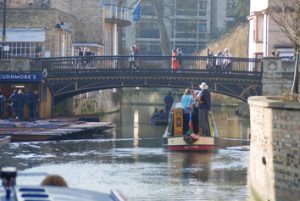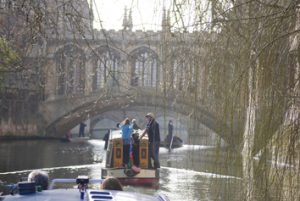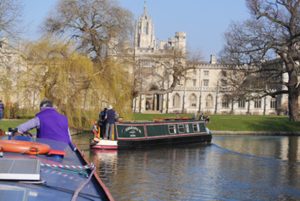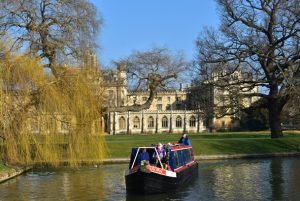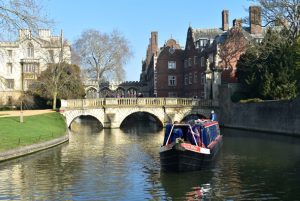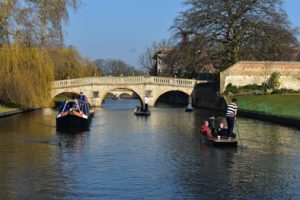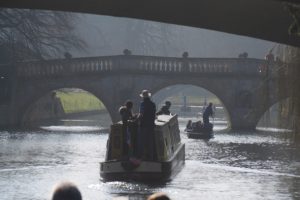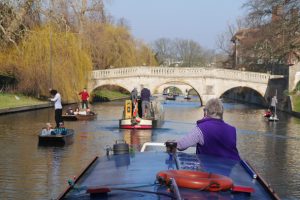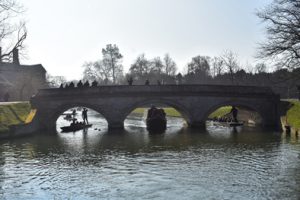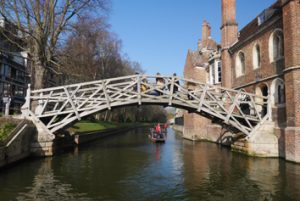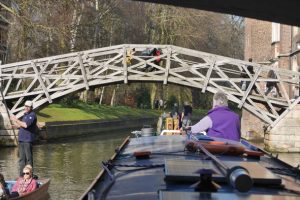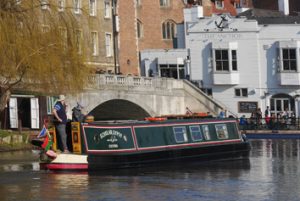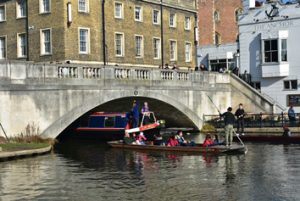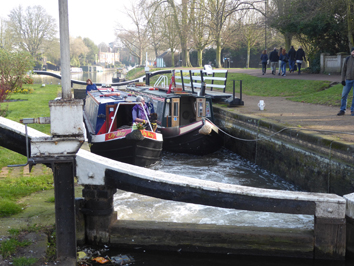
Jesus Green Lock
More than half a century ago, one of the founding fathers of the Inland Waterways Association, Robert Aickman wrote about the “Seven Wonders of the Waterways”. I’ve boated each of these Wonders and ticked them off my ‘to visit’ list. Although such structures as the Pontycysyllte Aqueduct obviously deserve every accolade available, while I marveled at Stanedge Tunnel, half way through I did ‘wonder’ just how much I was enjoying it. When we started up Caen Hill in tandem with another narrowboat, (who decided without warning to turn back after the lower 7 locks!), I ‘wondered’ how much I was enjoying the experience when halfway up the remaining 22 locks a descending hire boat decided to fully open the sluices of the empty lock I was in, without either asking, or warning, me !
I have another, personal, list – the “Seven Most Wonderful Places to Boat”. There are some occasions on which I have had to pinch myself because I can’t believe that I’m lucky enough to be boating in such a breathtakingly wonderful place. Clearly, crossing the Pontycysyllte comes high up on the list. But add to that list, mooring in the historic Royal Albert Dock in Liverpool- oozing history from every piece of stone and iron column, or visiting Bristol floating harbour and steaming past the S.S. Great Britain to visit the Harbour Master. Mooring in the heart of Bath with the gorgeous Georgian terraces rolling down the hill in front of you. The breathtaking beauty of crossing the Pennines on the Leeds & Liverpool, or mooring on the Thames in front of Hampton Court Palace with the evening sunlight bathing Jean Tijou’s magnificent wrought iron gates in its golden glow. Travelling up the truly beautiful River Nene in spring when the may blossom fills the valley of the clear flowing river, populated with historic watermills and beautiful stone villages each crowned by a picturesque church. These are just some of my favourite things !
And on a roasting, shirtsleeved February day (the warmest since records began) in bright sunshine we experienced a new ‘drop-dead gorgeous’, not to be missed, special boating location – the Cambridge Backs. This is probably the most beautiful area of the River Cam, above Jesus Green Lock. It flows past some of Cambridge’s finest buildings (including King’s College Chapel) and provides that world-famous view of Cambridge.
Navigation is prohibited to powered craft during the summer. This is probably just as well because in high season this part of the river becomes a confused mass of hundreds of punts, bobbing haphazardly across the river like a confused giant children’s game of ‘Pick-Up Sticks’. But between 1st October and 31 March access is permitted, so long as you give the river manager 48 hours notice.
The idea of taking up this seasonal opportunity to boat this famous stretch of water was put into our minds by Simon Judge, doyen of St Pancras Cruising Club, in a Facebook entry inviting interested parties to join him on a cruise on the last Saturday of February. We jumped at the opportunity to accompany Simon in our 45 narrowboat ‘Lily May’, bought the necessary Cam Licence (an addition to the EA licence required to get as far up the Cam as Bottisham Lock).
We boated up to Cambridge on the Friday, easily finding space on the visitor moorings below Jesus Green Lock. Being permitted to take your home (snail like) and moor it in the middle of one of our great cities is to me one of the true marvels on boating the Inland Waterways. We over-nighted in Cambridge (where the cost of an hotel is eye watering) for absolutely nothing !
As the sun struggled to burn through the morning mist we assembled at the lock, where Simon joined us in ‘Scholar Gypsy’ (title of a poem by Matthew Arnold, son of that other great University City, Oxford). Jesus Green Lock is one of those logic defying locks with the only means of crossing from one side of the lock to the other, by swing bridge which spans the lock and has to be removed before you can fill the lock, a seeming impossibility for the single-handed boater. Fortunately between the two boats we were well crewed.
The short journey requires passing under 10 bridges. By the time we had reached the first, Magdalen, the sun had conquered its battle with the morning mist, and we were bathed in glorious sunshine !
There are two considerations that the intrepid boater of Cambridge Backs ignores at their peril. Bridges and punts ! The height of the bridges requires careful attention. The third one you pass under, St. John’s Kitchen Bridge is the lowest, with a published air clearance of six foot nine inches. However one is well advised to remember that:-
a) like any river the water levels in the Cam rise after rain, and clearances quickly reduce,
b) the published height is to the centre of an arc, and will be lower where the corners of your boat pass under,
c) the computation of air clearance assumes that your boat is passing under at right angles to the line of the bridge, and on a narrow and bendy river the effects of wind and other boaters can combine to make it harder to ‘shoot the bridge‘ in a perpendicular line.
A punt is a flat-bottomed boat with a square-cut bow and stern, about 24 feet long and 3 feet wide, designed for use in small rivers and shallow water. The punter propels the punt by pushing against the river bed with a 12 – 16 foot long pole. Pleasure punting developed on the river Thames in the 1860s and arrived in Cambridge about 1902. The bows of a punt features a flat raised deck known as the ‘trill’ and the stern called the ‘huff’, which features cross plans (a.k.a. treads). The punter (propelling the boat) stands at one of the ends and pushes the boat away from him (or her). In Oxford the punter stands with a secure foot hold in the stern and proceeds bow first. However in Cambridge the punter stands on the flat raised bow or deck (with little secure foot grip) and propels the boat stern first. This less stable practice is said to have arisen in the Edwardian era when the lady undergraduates of Girton College felt it better showed off their ankles.
There is no towpath along this section of the Cam. In the 18th and 19th Centuries when deliveries were made to the Colleges it was by horse drawn barge. The Cam isn’t deep, and old prints show the horses wading chest-deep through the water, pulling barges and lighters. To facilitate this a cobbled causeway was laid down the centre of the river.
There are two kinds of punts in Cambridge, single width boats hired by the hour, generally to absolute novices, who laugh and splash and pose for selfies as they career haphazardly along the river, often crashing from side to side, sometimes assisted by the occasional alcoholic libation. There are also double width boats with ‘professional’ chauffeurs, propelling the boat, seemingly effortlessly, in a straight line (while dodging the beginners) straight up the middle of the river. These seasoned punters are following the hidden causeway along the centre of the river because it is far easier to propel their heavily laden boat by pushing off against solid cobbles than to allow the pole to sink into the clinging mud either side of this causeway.
The ‘middle of the river’ punt chauffeurs certainly aren’t prepared to surrender the precious centre of the bridges to narrowboats, pinball punting novices, or even other chauffeur punts. There is a famous annual 420 rowing boats race on the Thames in London where every cox has been told to ‘aim for the second lamp post on the right’ on Hammersmith Bridge, and the onlooker can revel in the chaos as all the boats steer for the same point, seemingly regardless of other boats. Similarly on the Cam, everyone heads for the centre of the bridges, with little or no consideration for other boats eyeing up the same destination !
The universal rule ‘steam gives way to sail’ clearly still applies, even if it has been transcribed to ‘beta 43 marine engine gives way to madly waving pole’ ! Of course it hasn’t crossed the punters’ minds that our boat may weigh 15 tons and doesn’t have brakes. Picking your way through, often on no more than tick-over, can feel like you are dancing around delicate china in hob nailed boots !
The custodians of the river, the Cam Conservators recommend positioning a look out in the bows, just to watch for wayward punts. By the first bridge punts were coming, from seemingly every direction, thick and fast. After the rather stodgy cast iron Victorian Magdalen Bridge, the next one is the Grade 1 listed Bridge of Sighs. There are a number of similarly named bridges around the world, but the inspirational original was constructed in 1600 in Venice and given the nick-name (which stuck) by Lord Byron. Cambridge’s was built in 1831, and bathed in the strong spring sunlight was breathtaking !
The next bridge, St John’s Kitchen Bridge, is a pleasant stone bridge. The Conservators ‘guide to navigating the … backs’ advises caution:
“this is the lowest and most challenging of all the bridges. Headroom at the apex of the largest middle arch is 2.08m / 6’9”. the curvature of the arch constrains the width available. You must ensure that your vessel is aligned dead-centre before proceeding. On the return passage, the entrance to the bridge is blind. Take especial care.”
Trinity Bridge, next, is another stone built bridge and is the second lowest bridge that we passed under. However, as we’d just squeezed under St John’s Kitchen Bridge, it wasn’t a problem. After a nondescript modern pedestrian bridge (Garret Hostel bridge) we arrived at Cambridge’s oldest, Clare Bridge. This is the only bridge to survive the English Civil War. Its considerable antiquity can be seen in its higgledy piggledy appearance.
After another stone bridge (King’s) we came to probably Cambridge’s most famous, the Mathematical Bridge. There is a popular myth that this bridge was designed and built by Sir Isaac Newton without the use of nuts or bolts, and that in the past students dismantled it, but couldn’t work out how to reassemble it again without using bolts. In fact mechanical fixings were always part of the design, it’s just that originally it employed spikes driven through the joints from outside (where they could not be seen from the inside of the parapets), whereas when it was rebuilt, big hand cut square bolts were used which are still highly visible. The bridge was originally constructed in 1749. Newton had already died in 1727 so his direct involvement in the bridge’s construction appears unlikely.
The last bridge is Silver Street. It’s a single span bridge, clad in Portland Stone, designed by Sr Edward Lutyens, and built in the late 1950s. In the middle it has a generous 8’7” air draft, but immediately upstream (to the left as we were travelling) is Mill Lane punting station with rafts of moored punts. We had to turn 90 degrees right immediately as we emerged from under the bridge, a manoeuvre made harder by extremely slow speed and punts absolutely everywhere.
We had reached Head of Navigation. There is a small weir, and the only boats that could access the river above the weir (here called Granta, despite remaining the Cam) were either boats that could be lifted by hand, or punts which are dragged across rollers. We winded in the mill pond, known as the Mill Pit. The Conservator’s navigation guide advises: “allow the water coming over the weir to carry the bows around”.
Travelling up the Cam from Jesus Green Lock had taken about an hour. It took at least another hour to retrace our route back to Jesus Green Lock. If possible, progress was even slower on the return journey, as the unseasonably stunning weather had attracted even more punts to the water. I often observe “if I was in a hurry I wouldn’t have bought a boat”. Nowhere does this more apply than to the Cambridge Backs. However the most leisurely cruising speed I can ever remember adopting, gives you more time to enjoy the uniquely special views of Cambridge from the water.
The Backs have become a firm entry into my “Seven Most Wonderful Places to Boat” list of uniquely special locations, but I doubt, however many times we might boat the Backs again in the future, that the weather will ever be so kind to us as on this trip !
Please be aware that a trip on the backs cannot be done during the hire boat season. You can however take a punt from Scudamores to recreate this journey on a weeks boating holiday from our March base..
To get more tips and advice about exploring Cambridgeshire and the Fens sign up now to receive regular articles by email. (See ‘Follow Blog’ to the right of this article.)
